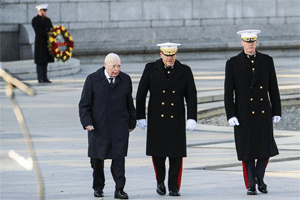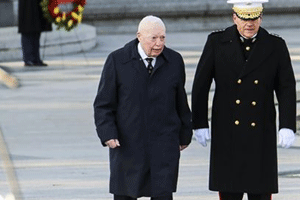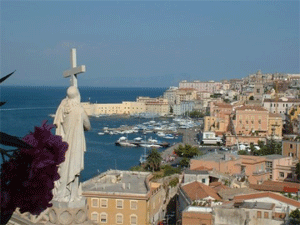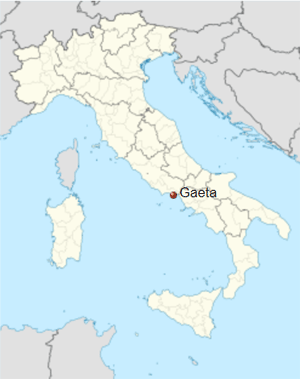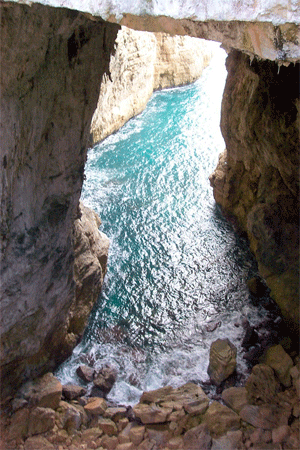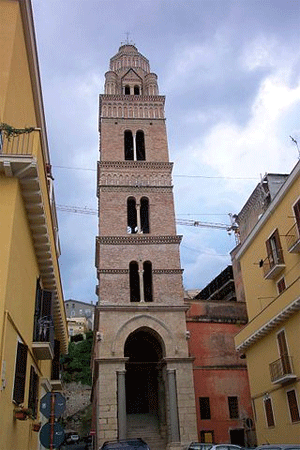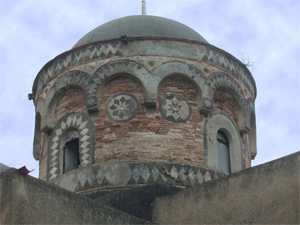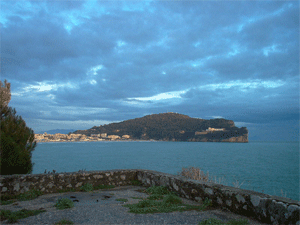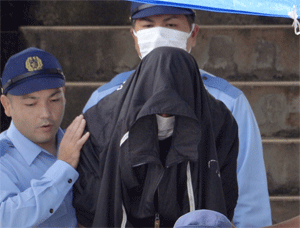The Hidden (And Not So Hidden) Messages in Stanley Kubrick’s “Eyes Wide Shut”, Part 1 by The Vigilant Citizen: "Symbols Rule the World, Not Words Nor Laws"
July 8, 2013
NOTICE: THIS WORK MAY BE PROTECTED BY COPYRIGHTYOU ARE REQUIRED TO READ
THE COPYRIGHT NOTICE AT THIS LINK BEFORE YOU READ THE FOLLOWING WORK, THAT IS AVAILABLE SOLELY FOR PRIVATE STUDY, SCHOLARSHIP OR RESEARCH PURSUANT TO 17 U.S.C. SECTION 107 AND 108. IN THE EVENT THAT THE LIBRARY DETERMINES THAT UNLAWFUL COPYING OF THIS WORK HAS OCCURRED, THE LIBRARY HAS THE RIGHT TO BLOCK THE I.P. ADDRESS AT WHICH THE UNLAWFUL COPYING APPEARED TO HAVE OCCURRED. THANK YOU FOR RESPECTING THE RIGHTS OF COPYRIGHT OWNERS.
“Eyes Wide Shut” was promoted as a steamy, suspenseful movie starring the “It” couple of the day: Tom Cruise and Nicole Kidman. While the actors were prominently featured in the movie, it is everything around them that told the true story of “Eyes Wide Shut”.
Stanley Kubrick’s attention to detail and symbolism gave the movie an entire other dimension – one that cannot be seen by those who have their eyes wide shut. This multiple-part series will look at the hidden symbolism of Kubrick’s final film.
I remember when I first watched Eyes Wide Shut, back in 1999. Boy, did I hate it. I hated how slow everything was, I hated how Nicole Kidman tried to sound drunk or high and I hated seeing Tom Cruise walking around New York looking concerned. I guess I reacted the same way critics did at the time the movie came out and thought: “This movie is boring and there is nothing hot about it.” More than a decade later, equipped with a little more knowledge and patience, I re-watched the movie … and it blew my mind. In fact, like most Stanley Kubrick films, an entire book could be written about the movie and the concepts it addresses.
Eyes Wide Shut is not simply about a relationship, it is about all of the outside forces and influences that define that relationship. It is about the eternal back-and-forth between the male and female principles in a confused and decadent modern world. Also, more importantly,
it is about the group that rules this modern world – a secret elite that channels this struggle between the male and female principles in a specific and esoteric matter. The movie, however, does not spell out anything. Like all great art, messages are communicated through subtle symbols and mysterious riddles.
Stanley Kubrick unexpectedly died only five days after submitting the final cut of the movie to Warner Bros, making Eyes Wide Shut his swan song. Considering the fact that Eyes Wide Shut is about an occult secret society that eliminates those who cross its path, some theories arose about Kubrick’s death and its suspicious nature. Did he reveal to the public too much, too soon? Maybe.
Let’s look at the main themes of Kubrick’s last creation.
The Modern CoupleThe stars of Eyes Wide Shut were the “It” couple of 1999: Tom Cruise and Nicole Kidman. Those who were expecting the movie to be a sort of voyeuristic experience showing hot scenes of the couple were probably very disappointed. The audience rather got a cold, egoistic and profoundly unsatisfied couple, one that seems to be tied together not by pure love, but by other factors, like convenience and appearances. While the couple is very “modern” and “upper-class”, the forces that keep it together are the result of basic, primal and almost animalistic behavior. If we look at the instinctive behavior of humans and animals, males primarily look for females that have good child-bearing qualities while females look for a strong provider. Remnants of this behavior still exist today as males tend to display wealth and power to attract females while females showcase their beauty to attract males. In Eyes Wide Shut, the couple perfectly follows that instinctive script.
Tom Cruise’s character is called Dr. Bill … as in dollar bill. Several times during the movie, Dr. Bill either waves his money or his “doctor badge” at people to get them to do what he wants. Bill is part of the upper class and his dealings with people of the lower class are often resolved with money.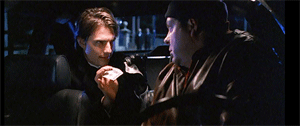 In order to get this taxi driver to wait for him in front of the mention, Dr. Bill tears up a hundred dollar bill and promises him to give him the other half when he comes back. Dr. Bill's motto is probably "Everybody has a price".
In order to get this taxi driver to wait for him in front of the mention, Dr. Bill tears up a hundred dollar bill and promises him to give him the other half when he comes back. Dr. Bill's motto is probably "Everybody has a price".Played by Nicole Kidman, Alice lost her job in the art world and is now fully supported by her husband’s salary. While she lives very comfortably, Alice appears to be extremely bored with her life as a stay at home mother.
The name Alice is most likely a reference to the main character of Alice in Wonderland – a fairy tale about a privileged girl who is bored with her life and who goes “through the looking glass” to end up in Wonderland. In Eyes Wide Shut, Alice is often shown staring at the looking glass – grooming herself or … maybe looking for something more to life. Alice spends a lot of time in front of the mirror being pretty - maybe because it is the only "attribute" that keeps her in that social status. Her daughter, Helena (maybe named after Helena of Troy, the most beautiful woman in the world) follows in her footsteps.
Alice spends a lot of time in front of the mirror being pretty - maybe because it is the only "attribute" that keeps her in that social status. Her daughter, Helena (maybe named after Helena of Troy, the most beautiful woman in the world) follows in her footsteps. Promotional images for the movie feature Alice kissing Bill but looking at herself in the mirror, almost as if she was seeing an alternate reality.
Promotional images for the movie feature Alice kissing Bill but looking at herself in the mirror, almost as if she was seeing an alternate reality.While the couple shows signs of fatigue, Bill and Alice put on their “happy masks” when it is time to attend social events. Like the elite people they socialize with, there is a big difference between the facade they put on and reality.
Brushing With the EliteBill and Alice go to a classy party given by Victor Ziegler, one of Bill’s wealthy patients. Judging from Victor’s house, he is not simply rich, he is part of the ultra-elite. While his party is very elegant and is attended by highly cultured people, it doesn’t take long for the viewers to realize that this facade hides a disgusting dark side. Also, small details inserted by Kubrick hint to a link between the party and the occult ritual that occurs later in the movie. When entering the party, the first thing we see is this peculiar Christmas decoration. This eight-pointed star is found throughout the house.
When entering the party, the first thing we see is this peculiar Christmas decoration. This eight-pointed star is found throughout the house. The star at Zeigler’s house is nearly identical to the ancient symbol of the star of Ishtar.Knowing Kubrick’s attention to detail, the inclusion of the star of Ishtar in this party is not an accident. Ishtar is the Babylonian goddess of fertility, love, war and, mostly, sexuality. Her cult involved sacred prostitution and ritual acts
The star at Zeigler’s house is nearly identical to the ancient symbol of the star of Ishtar.Knowing Kubrick’s attention to detail, the inclusion of the star of Ishtar in this party is not an accident. Ishtar is the Babylonian goddess of fertility, love, war and, mostly, sexuality. Her cult involved sacred prostitution and ritual acts – two elements we clearly see later in the movie.
“Babylonians gave Ishtar offerings of food and drink on Saturday. They then joined in ritual acts of lovemaking, which in turn invoked Ishtar’s favor on the region and its people to promote continued health and fruitfulness.”
– Goddess Ishtar, Anita Revel
Ishtar herself was considered to be the “courtesan of the gods” and had many lovers. While inspired in bed, she was also cruel to the men that got attached to her. These concepts will constantly reappear in the movie, especially with Alice.
During the party, Bill and Alice go their separate ways and are both faced with temptation.
Alice meets a man named Sandor Szavost who asks her about Ovid’s Art of Love. This series of books, written during the times of Ancient Rome, was essentially a “How to Cheat on Your Partner” guide, and was popular with the elite of the time. The first book opens with an invocation to Venus – the planet esoterically associated with lust. Interestingly enough, Ishtar (and her equivalents in other Semitic cultures) was considered to be the personification of Venus.
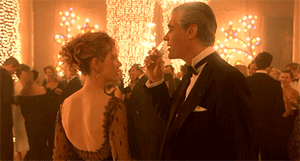 Sandor drinks from Alice’s glass. This trick is taken right out of Ovid’s The Art of Love. It sends Alice a message that is not very subliminal: “I want to exchange fluids with you”.Sandor’s name might be a reference to the founder of the Church of Satan: Anton Szandor Lavey. Is this Kubrick’s way of saying that this man, who urges Alice to cheat on her husband, is a part of the occult elite and its decadent ways? The Hungarian man is apparently skilled in neuro-linguistic programming (NLP) as he nearly hypnotizes Alice with well-calculated phrases about the futility of married life and the necessity of pursuing pleasure.
Sandor drinks from Alice’s glass. This trick is taken right out of Ovid’s The Art of Love. It sends Alice a message that is not very subliminal: “I want to exchange fluids with you”.Sandor’s name might be a reference to the founder of the Church of Satan: Anton Szandor Lavey. Is this Kubrick’s way of saying that this man, who urges Alice to cheat on her husband, is a part of the occult elite and its decadent ways? The Hungarian man is apparently skilled in neuro-linguistic programming (NLP) as he nearly hypnotizes Alice with well-calculated phrases about the futility of married life and the necessity of pursuing pleasure.
Meanwhile, Bill is discussing with two flirtatious models who tell him that they want to take him to “where the rainbow ends”. While the meaning of this enigmatic phrase is never explicitly explained in the movie, symbols talk for themselves.
Rainbows EverywhereRainbows and multicolored lights appear throughout the movie, from the beginning to the end.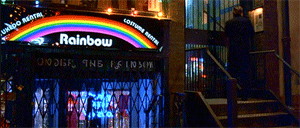 The name of the store where Bill rents his costume is called “Rainbow”. The name of the store under it: “Under the Rainbow”. Kubrick is trying to tell us something…Something involving rainbows.
The name of the store where Bill rents his costume is called “Rainbow”. The name of the store under it: “Under the Rainbow”. Kubrick is trying to tell us something…Something involving rainbows.As if to emphasize the theme of multicolored rainbows, almost every scene in the movie contains multicolored Christmas lights, giving most sets a hazy, dreamy glow.
 Almost every time Bill enters a room, the first things we see are multicolored Christmas lights.
Almost every time Bill enters a room, the first things we see are multicolored Christmas lights. Sometimes Christmas lights are the focal point of attention.
Sometimes Christmas lights are the focal point of attention.These lights tie together most scenes of the movie, making them part of the same reality. There are however a few select scenes where there are absolutely no Christmas lights. The main one is Somerton palace – the place where the secret society ritual takes place.
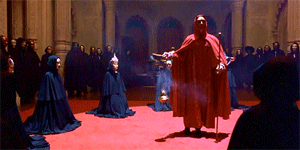 Sharply contrasting with the rest of the movie, Sommerton is completely devoid of multicolored lights. Everything about this place is in sharp opposition to the “outside world”.In Eyes Wide Shut, there are therefore two worlds: The Christmas lights-filled “rainbow world”, where the masses wander around, trying to make ends meet and the other world… “where the rainbow ends”- where the elite gathers and performs its rituals. The contrast between the two worlds gives a sense of an almost insurmountable divide between them. Later, the movie will clearly show us how those from the “rainbow world” cannot enter the other world.
Sharply contrasting with the rest of the movie, Sommerton is completely devoid of multicolored lights. Everything about this place is in sharp opposition to the “outside world”.In Eyes Wide Shut, there are therefore two worlds: The Christmas lights-filled “rainbow world”, where the masses wander around, trying to make ends meet and the other world… “where the rainbow ends”- where the elite gathers and performs its rituals. The contrast between the two worlds gives a sense of an almost insurmountable divide between them. Later, the movie will clearly show us how those from the “rainbow world” cannot enter the other world.
So, when the models ask Bill to go “where the rainbow ends”, they probably refer to going “where the elite gathers and performs rituals”. It might also be about them being dissociated Beta Programming slaves. There are several references to Monarch mind control (read this article for more information) in the movie. Women who take part in elite rituals are often products of Illuminati mind control. In MK Ultra vocabulary, “going over the rainbow” means dissociating from reality and entering another persona (more on this in the next article). The models ask Bill to leave the “rainbow world” (there’s a Christmas tree right behind them) to indulge in the debaucherous rituals of the occult elite.Behind the Curtain
The models ask Bill to leave the “rainbow world” (there’s a Christmas tree right behind them) to indulge in the debaucherous rituals of the occult elite.Behind the CurtainBill’s flirting with the models is interrupted when Ziegler calls him to his bathroom. There, we get a first glance of “where the rainbow ends” – the dark truth about the elite.
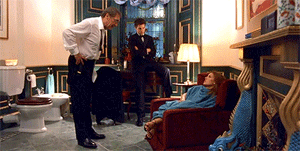 Bill meets Ziegler in his gigantic bathroom. The man is dressing up and is with a naked unconscious woman…who is not his wife.
Bill meets Ziegler in his gigantic bathroom. The man is dressing up and is with a naked unconscious woman…who is not his wife.If we rewind a little, when Bill and Alice first entered the party, they were welcomed by Ziegler and his wife in a room filled with Christmas lights. We saw two respectable couples talking about respectable things in a room full of enchanting lights. But when Bill goes “where the rainbow ends” (notice there are no Christmas lights in the bathroom) we see reality: Ziegler with a Beta programming slave who overdosed on goofballs. When the woman gains consciousness, Ziegler talks to her in an odd, paternal matter, highlighting the fact that he’s the master and she’s the slave. The luxurious setting of this scene is Kubrick’s way of saying that extreme wealth does not necessarily equal high morals.
Ziegler then urges Bill to keep everything he just saw a secret. The world “where the rainbow ends” must never be revealed to the outside world. It operates in its own space, has its own rules and depends on the masses’ ignorance.
Questioning MarriageWhile Alice ultimately rejected Sandor’s advances, she was nevertheless enticed by them. The next day, Alice tells Bill that she could have cheated on him at the party.
When Bill tells his wife that he loves and trusts her, she completely loses it. She then proceeds to tell him a story about how she was once ready to cheat on him with a naval officer she met in a hotel. This cruel story highlights the “Ishtar” side of Alice as she brings up in her husband feelings of jealousy, insecurity, betrayal, and even humiliation. In short, Alice purposely summoned everything that is negative in relationships to pop Bill’s “love bubble”. This wake-up call prompts Bill to embark on a strange journey around New-York city, one that has multiple levels of meanings. That strange night will ultimately lead him to the exact opposite of a monogamous relationship: Anonymous, masked copulation with strangers in a ritual setting. Bill’s journey will be further analyzed in the second part of this series of articles.
Conclusion of Part OneThe first part of this series about Eyes Wide Shut took a broad look at Bill and Alice, a modern couple that has the “privilege” of brushing with the upper-echelon of New York. While everything appears great on the surface, Kubrick quickly tells the viewers to not be deceived by appearances and to not be impressed by exhibitions of wealth. Because, behind the “rainbow world”, exists a dark and disturbing reality, one that Kubrick exposes in many subtle ways throughout the movie.
While Bill and Alice are simply “guests” in the elite circle, they are nevertheless fascinated and attracted by it. They see in this lifestyle a way of fulfilling their dark and secret needs. In the next part of this series, we’ll look at the occult meaning of Bill’s journey – a story told by subtle symbols peppered throughout the movie.
__________________________________
Part 2
July 18, 2013
The second part of this series of articles on Eyes Wide Shut takes a closer look at the elite secret society discovered by the film’s main character, Bill Harford, and how it resembles real life organizations.
Was Stanley Kubrick trying to warn the world about the occult elite and its depraved ways?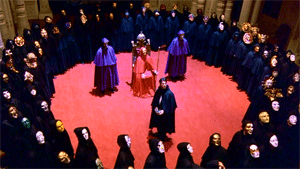
In the first part of this series on Eyes Wide Shut, we looked at main characters of the film and the symbolic world Kubrick created around them. We saw that Bill and Alice Harford are a married upper-class couple that was not immune to the temptations of adultery. We also saw that the couple was in contact with the upper-echelon of New-York and its decadent ways – a world that fascinates Bill, but that has a dark side, one that is kept from the public. In this article, I will jump straight to the most unsettling part of the movie: The secret society ritual.
When Bill learns that his wife has considered cheating on him, he embarks on a strange series of encounters (which I will analyze in the third and final part of this series), eventually ending up in a luxurious house in Long Island where he encounters a large gathering of masked individuals partaking in an occult ritual. Since he was never initiated into that secret society, Bill was not even supposed to know that it existed, let alone bear witness to one of its “meetings”. So how did he find out about this thing? Well, a little birdie told him.
Nick NightingaleAt one point during his strange night out, Bill meets his old friend Nick Nightingale at a jazz cafe. The professional piano player reveals to Bill that he is sometimes hired by mysterious people to play, blindfolded, during mysterious parties that are full of beautiful women. This juicy piece of information intrigues Bill to the highest degree because. Since his talk with his wife, he appears to be looking for some kind of … experience. Nick ultimately makes a big mistake and agrees to provide Bill with all of the information needed to access the venue.
A nightingale is the type of bird that is known for singing at night, just like Nick Nightingale “sings” secret information at the start of Bill’s fateful night.
The password to enter the ritual is “Fidelio”, which means “faithfulness”, a main theme of the movie. More importantly, as Nightingale points out, “Fidelio” is the name of an opera written by Beethoven about a wife who sacrifices herself to free her husband from death as a political prisoner. This password actually foreshadows what will happen during that ritual.
After getting the details from Nightingale, Bill rents a costume at a store named “Rainbow” (more about the store in the next article) … and then proceeds to go to Somerton, the estate where the party is being held.
The Occult Elite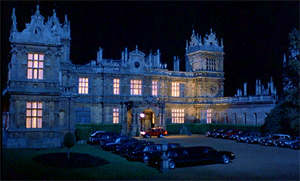 The occult ritual takes place at Somerton, in Long Island. The building used to film the outside scene is Mentmore Towers in the UK.
The occult ritual takes place at Somerton, in Long Island. The building used to film the outside scene is Mentmore Towers in the UK.The location selected to film the elite scenes is quite interesting.
Mentmore Towers was built in the 19th century as a country house for a member of the most prominent and powerful elite family in the world: The Rothschilds. By selecting this location, was Kubrick trying to show his audience the “real world” equivalents to the ultra-elite shown in the movie? Incidentally, the name of Bill’s connection to the elite, Victor Ziegler, is of German-Jewish origins, like Rothschild.
It has been documented that the Rothschilds do actually partake in masked events very similar to those shown in Eyes Wide Shut. Here are rare pictures from a 1972 party given by Marie-Hélène de Rothschild.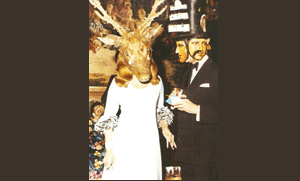 Baroness Marie-Hélène de Rothschild and Baron Alexis de Redé at a 1972 party. Invitations were printed in reversed writing. One wonders if this party “degenerated” into something resembling what is shown in Eyes Wide Shut.
Baroness Marie-Hélène de Rothschild and Baron Alexis de Redé at a 1972 party. Invitations were printed in reversed writing. One wonders if this party “degenerated” into something resembling what is shown in Eyes Wide Shut.In the movie, when Bill enters the mansion, he mixes with a crowd of masked people silently watching the ritual. One of these people appears to instantly recognize Bill (or the fact that he doesn’t belong here).
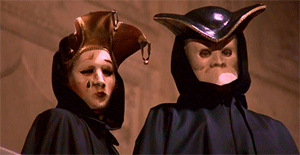 A couple wearing Venetian masks (more specifically “female jester” and “bauta” masks) slowly turn towards Bill and nod in a very creepy matter. Ziegler and his wife? Perhaps. Kubrick likes to keep things mysterious.Venetian masks were originally worn during the Italian Renaissance in Venice and were a way for the powerful elite of the time to indulge in debauchery without reprisal.
A couple wearing Venetian masks (more specifically “female jester” and “bauta” masks) slowly turn towards Bill and nod in a very creepy matter. Ziegler and his wife? Perhaps. Kubrick likes to keep things mysterious.Venetian masks were originally worn during the Italian Renaissance in Venice and were a way for the powerful elite of the time to indulge in debauchery without reprisal.“Though the precise origin of the mask-wearing tradition can’t be known for certain, the prevailing theory goes something like this: beginning in the Italian Renaissance, Venice was an extremely wealthy and powerful merchant empire. Its position on the Mediterranean sea opened it up to a myriad of trading opportunities across Europe, North Africa and Asia Minor, and its powerful navy allowed it to exert the military force necessary to defend its vast wealth. In a city-state so prosperous, it’s a small wonder that Venetian society was class-obsessed and rigidly stratified. One’s individual standing was immensely important for the perception of his or her entire family, and so naturally the pressure to act in accordance with the social morays governing one’s social standing was immense and stifling. The Venetians, the theory goes, adopted the practice of wearing masks and other disguises during the Carnival season as a way of suspending the rigid social order. Under the cloak of anonymity, the citizens of Venice could loosen their inhibitions without fear of reprisal. Masks gained so much popularity that the mascherari (mask makers) became a venerated guild in Venetian society. However, as word of the famed Venetian Carnival spread, more and more outsiders flocked to the city every year to take part in the festivities. The Carnival celebrations became increasingly chaotic and debaucherous as the years progressed until their decline in the 18th Century.”
– Geoffrey Stanton, Guide to Venetian Carnival Masks
Since then, Venetian masks have been used in elite circles and have somewhat become a symbol of its dark occult philosophy. Even The British Royal Family appears to enjoy the same type of masks and events.
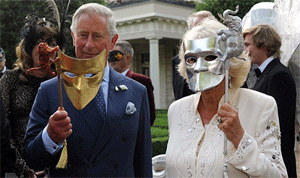 Prince Charles and Duchess Camilla at Clarence House with bauta masks.
Prince Charles and Duchess Camilla at Clarence House with bauta masks.That particular Royal event featured masked women who were as NOT dressed as those in the Eyes Wide Shut ritual.
 Models at the party attended by the Royal Family.
Models at the party attended by the Royal Family.It seems evident that Kubrick carefully selected the Rothschild-owned location and hand-picked the masks worn by participants of the ritual, echoing real-life families and events.
Setting of the RitualWhen Bill enters Somerton, everything about the movie changes. There are no more colorful Christmas lights and no tacky decorations. Instead of incessant chatter between needy people, it is all about stillness and silence.
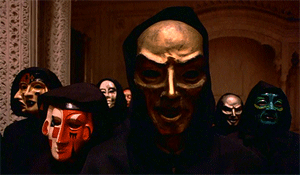 Staring right at the camera (and at the movie viewers), the creepy masks are silent yet disturbing reminders showing the “true faces” of the elite. Note that the multi-faced mask on the left which is similar to the one worn at the Royal party above.The music in the movie also changes drastically. The song heard in the background is called “Backwards Priests” and features a Romanian Orthodox Divine Liturgy played backward. The reversal or inversion of sacred objects is typical of black magic and satanic rituals. By having this Christian liturgy played backward right before widespread fornication is Kubrick’s way of stating that the elite is nothing less than satanic.
Staring right at the camera (and at the movie viewers), the creepy masks are silent yet disturbing reminders showing the “true faces” of the elite. Note that the multi-faced mask on the left which is similar to the one worn at the Royal party above.The music in the movie also changes drastically. The song heard in the background is called “Backwards Priests” and features a Romanian Orthodox Divine Liturgy played backward. The reversal or inversion of sacred objects is typical of black magic and satanic rituals. By having this Christian liturgy played backward right before widespread fornication is Kubrick’s way of stating that the elite is nothing less than satanic.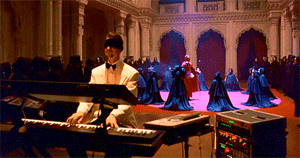 Here we see Nick Nightingale playing the song “Backwards Priest”, meaning that people in the ritual actually hear that music and that the whole thing is choreographed to it. Nightingale is blindfolded because the “profane” cannot witness the occult rituals of the elite.
Here we see Nick Nightingale playing the song “Backwards Priest”, meaning that people in the ritual actually hear that music and that the whole thing is choreographed to it. Nightingale is blindfolded because the “profane” cannot witness the occult rituals of the elite.The interior scenes of the party were shot at Elveden Hall, a private house in the UK designed to look like an Indian palace.
When the “festivities” begin, a Tamil song called “Migration” plays in the background, adding to the South-Asian atmosphere (the original version of the song contained an actual scriptural recitation of the Bhagavad Gita, but the chant was removed in the final version of the movie). This peculiar Indian atmosphere, combined with the lascivious scenes witnessed by Bill as he walks around the house, ultimately points towards the most important, yet most hidden part of the movie: Tantric Yoga and its Western occultism derivative, Sex Magick. This last concept was “imported” by British occultist Aleister Crowley and is now at the center of the teachings of various secret societies:“Aleister Crowley’s connections with Indian Yoga and Tantra were both considerable and complex. Crowley had direct exposure to some forms of these practices and was familiar with the contemporary literature of the subjects, wrote extensively about them, and – what is perhaps the most important – he practiced them. In his assessment of the value of Tantra, he was ahead of his time, which habitually considered Tantra a degenerate form of Hinduism. Instead, he claimed that, “paradoxical as it may sound the Tantrics are in reality the most advanced of the Hindus”. Crowley’s influence in bringing Eastern, primarily Indian, esoteric traditions to the West extends also to his incorporation of the elements of Yoga and Tantra into the structure and program of two influential magical orders, the A.:A.: and
the OTO.”
– Martin P. Starr, Aleister Crowley and Western Esotericism
The above quote stipulates that Tantric concepts were incorporated in two important secret societies: the A.:A.: and the OTO (
Ordo Templi Orientis). The OTO is still extremely influential in elite circles and reaches the highest levels of politics, business, and even the entertainment industry.
At the core of these orders is the Thelema, a philosophy created by Aleister Crowley that he summed up with the saying “Do What Thou Wilt”. This saying is actually a translation of “Fais ce que tu voudras” the motto of an 18th-century secret society, the infamous Hellfire Club.
Hellfire Clubs were said to be “meeting places of ‘persons of quality’ who wished to take part in immoral acts, and the members were often very involved in politics”. According to a number of sources, their activities included mock religious ceremonies, devil worship, and occult rituals. Although details are vague regarding that elite club, they were known for performing elementary Satanic rites as a prelude to their nights of fornication. These acts were however not just “for fun” or to “shock people” as some sources might claim, the members were initiates of occult mysteries and their rituals were based in ancient rites involving invocations and other forms of black magick.
In short, although Kubrick never actually names the secret society infiltrated by Bill, there are enough clues to understand what kind of club he is referring to. Most importantly, he is telling his viewers: These societies still exist … and they are more powerful than ever.The Ritual and its ParticipantsThe ritual begins with the High Priest, dressed in red, performing a ceremonial routine. He is at the center of a “magic circle” formed by young women who are very likely to be Beta Kitten slaves. Later, when Bill is unmasked, another magic circle is formed.
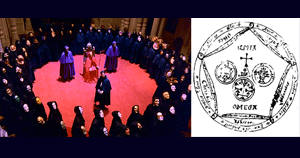 Magic circles is a concept used in ritual magic during invocations. The placement of the people in this scene recalls magic circles. Right: A magic circle as pictured in an ancient grimoire.
Magic circles is a concept used in ritual magic during invocations. The placement of the people in this scene recalls magic circles. Right: A magic circle as pictured in an ancient grimoire. The last scene of the movie takes place at a toy store – a place full of highly symbolic items (more on it in the next article). Here, Helena Harford walks by a toy called Magic Circle – showing that the occult elite’s ways seep through popular culture, but are not noticed by those who have their eyes wide shut.Amanda
The last scene of the movie takes place at a toy store – a place full of highly symbolic items (more on it in the next article). Here, Helena Harford walks by a toy called Magic Circle – showing that the occult elite’s ways seep through popular culture, but are not noticed by those who have their eyes wide shut.AmandaAt the beginning of the ritual, one of the Beta slaves goes to Bill and urges him to leave the house before he got caught. We ultimately learn that it was Amanda, the girl that was passed out in Ziegler’s bathroom.
When Bill gets caught and gets (literally) unmasked by the High Priest, Amanda appears at the balcony in a very dramatic fashion and tells the High Priest she wants to “redeem” him, in a tone that approaches ritual drama. The Priest then replies “Are you sure you understand what you’re taking upon yourself in doing this?” This implies that she will be repeatedly abused and then sacrificed.The next day, Bill discovers the true power of that secret society.
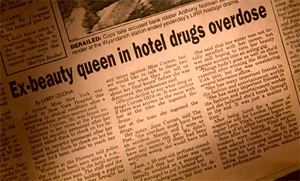 Bill discovers in the newspaper that Amanda was found dead in a hotel room due to an overdose. The way in which this ritualistic murder is disguised as an overdose is highly similar to the many celebrity ritual deaths disguised as overdoses that occur in real life.By freeze-framing and actually reading the above news article about Amanda, we learn important details about Amanda’s background (classic hidden sub-plot integration by Kubrick). To those “in the know”, the article perfectly describes the life of an entertainment industry Beta Programming slave (i.e. Marilyn Monroe). We indeed learn that Amanda was “emotionally troubled” as a teen and underwent “treatments” (a code word for MK Programming perhaps?), she had “important friends in the fashion and entertainment worlds”, and she had an “affair” with a powerful fashion designer who got “wowed by her private, seductive solo performances” (typical behavior of a Beta Kitten).
Bill discovers in the newspaper that Amanda was found dead in a hotel room due to an overdose. The way in which this ritualistic murder is disguised as an overdose is highly similar to the many celebrity ritual deaths disguised as overdoses that occur in real life.By freeze-framing and actually reading the above news article about Amanda, we learn important details about Amanda’s background (classic hidden sub-plot integration by Kubrick). To those “in the know”, the article perfectly describes the life of an entertainment industry Beta Programming slave (i.e. Marilyn Monroe). We indeed learn that Amanda was “emotionally troubled” as a teen and underwent “treatments” (a code word for MK Programming perhaps?), she had “important friends in the fashion and entertainment worlds”, and she had an “affair” with a powerful fashion designer who got “wowed by her private, seductive solo performances” (typical behavior of a Beta Kitten). What the article however conveniently doesn’t mention is that she was selling her body to elite people and being used in their occult rituals.
As it is the case for Beta Kittens who’ve gone “rogue”, she was eliminated by the people who controlled her life. The article states that she was last seen being escorted to her hotel room by two men and that she was “giggling” (drugged and dissociated?). Like “real life” elite sacrifices, “overdose” is cited as the cause of her death.
The High Priest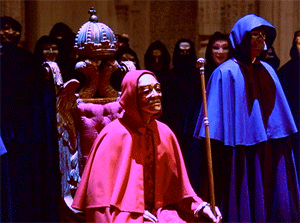 Cloaked in red, the High Priest sits on a throne which features a very important symbol: A double-headed eagle topped by a crown.
Cloaked in red, the High Priest sits on a throne which features a very important symbol: A double-headed eagle topped by a crown.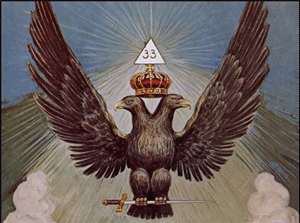 The double-headed eagle is one of the most ancient and prominent symbols of Freemasonry. A crowned double-headed eagle is representative of the 33rd degree of Freemasonry, the highest degree attainable. Is Kubrick implying that the High Priest is a 33rd Degree Freemason?
The double-headed eagle is one of the most ancient and prominent symbols of Freemasonry. A crowned double-headed eagle is representative of the 33rd degree of Freemasonry, the highest degree attainable. Is Kubrick implying that the High Priest is a 33rd Degree Freemason?Like other participants of the ritual, the true identity of the High Priest is never revealed. However, Kubrick left a few clues hinting at his identity and his relationship with Amanda.
In the movie’s end credits (and sources such as IMDB), it is listed that the role of the High Priest was played by “assistant director” of the movie, Leon Vitali. If one carefully reads the news article mentioned above, Leon Vitali is the name of the London fashion designer Amanda had an “affair” with. Furthermore, the High Priest has an unmistakable English accent. We can, therefore, deduce that the High Priest is the fashion designer.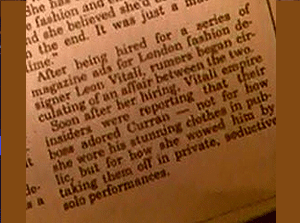 A snippet of the article mentioning Leon Vitali.This hidden subplot is interesting as it reveals the true nature of the fashion and entertainment industry. High-ranking individuals in these fields are initiated in occult secret societies and deal with MK slaves.The Power of the Secret Society
A snippet of the article mentioning Leon Vitali.This hidden subplot is interesting as it reveals the true nature of the fashion and entertainment industry. High-ranking individuals in these fields are initiated in occult secret societies and deal with MK slaves.The Power of the Secret SocietyWhen Bill is uncovered by the High Priest, he gets told that he and his family would pay for any transgression. The next day, he realizes that he is being followed by strange people and becomes paranoid.
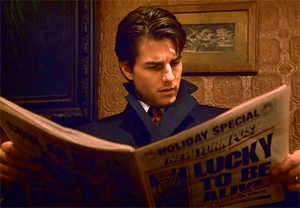 The headline of this newspaper is “Lucky to be alive”. This applies to Bill.
The headline of this newspaper is “Lucky to be alive”. This applies to Bill.Right after Bill leaves the morgue to confirm that Amanda died, Ziegler calls him and invites him over.
 Taking place in Ziegler’s pool room, the back and forth between the two men is more intense than any game of pool.
Taking place in Ziegler’s pool room, the back and forth between the two men is more intense than any game of pool.Although Bill is a rich doctor, he is not part of the elite. Ziegler’s attitude towards Bill makes it very clear. While Ziegler appears to want to be honest and straight with Bill, we realize that he is simply trying to cover the ugly truth. After all, Bill is an “outsider”. He tells Bill:
“I don’t think you realize what kind of trouble you were in last night. Who do you think those people were? Those were not just ordinary people there. If I told you their names – I’m not gonna tell you their names – but if I did, I don’t think you’d sleep so well.”
Ziegler, therefore, admits that people attending the ritual were high-level, well-known and powerful people. Kubrick is making clear that the richest, most powerful deciders of the “real world” meet in these types of rituals … and that these rituals are off-limits to the profane.When Bill mentions Amanda, Ziegler gets more defensive and replies: “She was a hooker” – meaning that she was a Beta slave that could be easily disposed of. Then Ziegler tells Bill that everything that happened at the ritual was a charade to scare him, Bill answers:
“You called it a fake, a charade. Do you mind telling me what kind of f—-cking charade ends with someone turning up dead?”
This highlights the fundamental difference between the public’s perception of occult rituals and what actually happens.
Regular people are lead to believe that these elite rituals are nothing more than goofy meetings of people with too much time on their hands. In reality, these elaborate rituals often incorporate real attempts at Black Magick and include real blood sacrifices and other terrible acts.Then Ziegler proceeds to tell Bill the same stuff media tells the masses when someone has been sacrificed by the elite: She OD’ed, she was a junkie, it was only a matter of time, and the police did not see any foul play.
Conclusion of Part IIThe second part of this analysis focused exclusively on the unnamed secret society Bill stumbles upon and its ritual. Although nothing is explicitly spelled out to the viewers, the symbolism, the visual clues and even the music of Eyes Wide Shut tell reveals a side of the occult elite that is rarely shown to the masses. Not only does the movie depict the world’s richest and most powerful people partaking in occult rituals, it also shows how this circle has also the power to exploit slaves, to stalk people, and even to get away with sacrificial murders. Even worse, mass media participates in covering their crimes.
The secret society in the movie closely resembles the infamous Hellfire Club, where prominent political figures met up to partake in elaborate Satanic parties. Today, the O.T.O. and similar secret societies still partake in rituals involving physical energy as it is perceived to be a way to attain a state of enlightenment. This concept, taken from Tantric yoga, is at the core of modern and powerful secret societies. Although none of this is actually mentioned in Eyes Wide Shut, the entire movie can be interpreted as one big “magickal” journey, characterized by a back-and-forth between opposing forces: life and death, lust and pain, male and female, light and darkness, and so forth … ending in one big orgasmic moment of enlightenment. This aspect of the movie, along with other hidden details, will be analyzed in the third and final part of this series of articles on Eyes Wide Shut.
_______________________________________
Part 3
August 16, 2013
In the third and final part of this series on Eyes Wide Shut, we’ll look at Bill’s journey as a whole and at its underlying esoteric meaning. We’ll see how symbolism placed by Kubrick connects all of the women in the movie, making Bill’s encounters a multi-faceted exploration of the feminine principle.
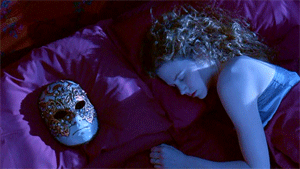
The previous parts of this series of articles on Eyes Wide Shut were solely dedicated to the secret society discovered by Bill. This elite club, attended by the world’s most powerful people, deals with Satanism, black magick, and even
ritual sacrifices. Aided by his friend Nightingale, Bill infiltrates one of the secret society’s occult rituals and witnesses a ceremony presided over by a high priest. Then an orgy ensued.
In the second article, I explained how real life secret societies, such as the Hellfire club and the O.T.O., actually practice these kinds of rituals.
The occult principles behind them derive from Tantric yoga, where the energy generated by physical arousal is used to reach a “higher state”. This concept was reused (and maybe corrupted) by Aleister Crowley who called it “Sex Magick”. According to him and his peers, knowledge of this type of magick was the biggest secret of past secret societies and was only disclosed to the highest initiates.There is, however, no (direct) mention of any of this in Eyes Wide Shut. In fact, the ceremony witnessed by Bill, with its elaborate choreography and its creepy music, appears to be one big, empty, phony piece of dramatic theater that simply exists to give the rich people some kind of mystical reason to engage in gratuitous debauchery. While Kubrick stripped the occult ritual of all of its esoteric, “magickal” meaning, he did infuse the entire movie with it. If one looks at the pace of the movie, at Bill’s journey and the people he encounters, it becomes somewhat apparent that the “magick” does not occur during the ritual itself but during the movie as a whole. Was Kubrick somehow initiated into occult secrets? Was he trying to communicate them through his movie? Let’s look at the concepts behind the ritual.
Kundalini RisingThe concept of magick through reproductive forces is said to originate from ancient ritual practices, as traces of it can be found in Hinduism, Taoism and in Medieval secret societies, such as the Knight Templars. In today’s Western world, the O.T.O is said to be the heir of this path as it claimed by Aleister Crowley and his acolyte,
Theodor Reuss.
“Theodor Reuss was quite categoric: the OTO was a body of initiates in whose hands was concentrated the secret knowledge of all oriental orders and of all existing Masonic degrees.(…) The order had “rediscovered” the great secret of the Knights Templar, the magic of sex, not only the key to ancient Egyptian and hermetic tradition, but to all the secrets of nature, all the symbolism of Freemasonry, and all systems of religion.”– Peter Tomkins, The Magic of Obelisks
The basic principle behind this “great secret” is the raising of the Kundalini or “life force”, an energy that can be used for magickal purposes.“In all Tantric magic, the essential requirement – whether in the ecstasy of couples or the solo ritual of a priestess – involved the raising of the energy known as the serpent of fire, or kundalini. This mysterious energy described as lying dormant in the lowest of the seven chakras, can be aroused by two distinct methods, called, traditionally, the right- and the left-hand path. The right hand allots supremacy to the male principle, the left to the feminine. As the serpent power is aroused, according to clairvoyants, it climbs up the backbone of the adept, energizing each chakra, till it emerges from the skull – symbolically as the snake’s head like those so clearly depicted in Egyptian statuary.
(…)
As adepts describe the rising of the serpent, it unites with the “many-petaled lotus of the cerebral region” to bring about illumination – or the highest form of initiation - as the current “climbs from the duality to unity by reversing the path it originally took the chakras to procreate humanity.”
Details of the OTO’s initiation into Hindu and Tibetan Tantra, including ceremonies involving the use of “exudation” from specifically trained priestess were brought to a wider public by Crowley’s follower Kenneth Grant. Sacred courtesans, experts in ritual eroticism, known in India as nautch girls (…) were exceptionally honored.”
– Ibid.
While sacred courtesans were “exceptionally honored” in Eastern esotericism, today’s twisted black magic orders use Beta Programming slaves and dispose of them when they are through with them. In short, the exact opposite of being “exceptionally honored”.Kundalini rising, the concept behind Tantric magic is wholly represented in a single image, Eliphas Levi’s depiction of Baphomet.
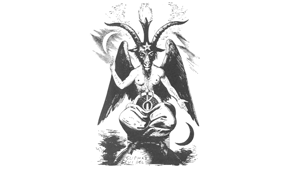 This famous depiction of Baphomet includes all of the symbols of Sex Magick – the rising of the kundalini (represented by the phallic pole wrapped by two serpents) through the union of opposite forces. The torch above the goat head represents illumination.
This famous depiction of Baphomet includes all of the symbols of Sex Magick – the rising of the kundalini (represented by the phallic pole wrapped by two serpents) through the union of opposite forces. The torch above the goat head represents illumination.So what does all of this have to do with Eyes Wide Shut? At first glance, nothing much. While we see a ritual involving “sacred courtesans” in the movie, there is absolutely no mention of “kundalini rising” during the whole thing. However, if we take a closer look at Bill’s journey as a whole, from the beginning of the movie to the end, we realize that the real ritual does not occur at the elite mansion but within Bill’s head. As he encounters new women and is exposed to new opportunities, his kundalini rises – and Kubrick added clues to denote this fact.
The Movie as a RitualWhile Eyes Wide Shut appears to be all about sexuality, nobody in the movie ever reaches climax. While Bill has many chances of satisfying his urges with attractive women, it never actually happens. However, as the movie progresses, there’s a definite increase in desire and lust, but Bill manages to keep it under control. Managing this “life force” is at the core of Tantric magic. Viewers are constantly reminded of this process several times during the movie when Bill imagines his wife with a naval officer. Each flash is increasingly intense – going from kissing to all-out copulating.
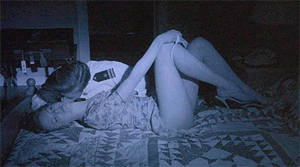 As the movie progresses, Bill’s flashes of Alice cheating on him become more intense. Towards the end of the movie, she’s about to reach climax. These scenes reflect Bill’s kundalini rising. Having these flashes would be hurtful and painful and they remind the viewers that Bill’s journey started out of pain and humiliation.
As the movie progresses, Bill’s flashes of Alice cheating on him become more intense. Towards the end of the movie, she’s about to reach climax. These scenes reflect Bill’s kundalini rising. Having these flashes would be hurtful and painful and they remind the viewers that Bill’s journey started out of pain and humiliation. Towards the end of the movie, Bill is so horny that he gets flirty and grabby with a complete stranger, minutes after he met her. While that scene was rather odd and surreal, it reflects his “progress” in the ritual.
Towards the end of the movie, Bill is so horny that he gets flirty and grabby with a complete stranger, minutes after he met her. While that scene was rather odd and surreal, it reflects his “progress” in the ritual.The very last lines of the movie conclude and define Bill’s journey. After running around New York and getting aroused by all kinds of stuff, Bill stands face-to-face with his wife and talks about how “awake” he is now. With his “life force” fully charged, Alice ends the movie with a phrase completing the ritual:
“- I do love you. And you know, there is something very important that we need to do as soon as possible.
– What’s that?
– F*ck.”
Ending the movie on that particular note suggests that the entire journey was one of increasing intensity, one that ultimately leads to a “magickally charged ” climax, the goal of Crowleyan-magick.Bill’s journey was not all fun and games, however. As the movie progresses, there is a constant back-and-forth between pleasure and pain, attraction and repulsion, life and death, and so forth. The path is all about duality and, just like the floors of Masonic lodges are checkered in black and white,
Bill’s journey consists on his alternatively stepping on black and white tiles – seeing the dualistic nature of all things.Eros and ThanatosBill’s night out in New York City is characterized by numerous encounters with the female gender – each one of them offering a “cure” to a broken heart. However, each encounter also bears a potentially destructive aspect to it, one that counterbalances its appeal and attraction.
While Bill is looking to procreate, he sees that his urges engender pain and even death. Bill’s journey is, therefore, a back-and-forth between man’s two basic impulses as defined by Freud: Eros and Thanatos.Freud saw in Eros the instinct for life, love and sexuality in its broadest sense, and in Thanatos, the instinct of death, aggression. Eros is the drive toward attraction and reproduction; Thanatos toward repulsion and death. One leads to the reproduction of the species, the other toward its own destruction. While each one of Bill’s encounters promises the sweet temptation of lust, they also have a destructive counter side.
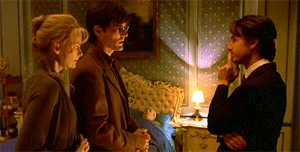 Bill’s first encounter occurs when he visits one of his regular patients that died. The dead patient’s daughter kisses Bill and tells him that she loves him. We, therefore, see in this scene a juxtaposition of concepts of lust and desire with death. Also, if Bill went with this woman, it would ultimately hurt her husband – another bad side of succumbing to lust.
Bill’s first encounter occurs when he visits one of his regular patients that died. The dead patient’s daughter kisses Bill and tells him that she loves him. We, therefore, see in this scene a juxtaposition of concepts of lust and desire with death. Also, if Bill went with this woman, it would ultimately hurt her husband – another bad side of succumbing to lust.Each one of Bill’s female encounters promises gratification but ends up being interrupted by something negative, such as guilt or potential danger. Also, every time Bill is in contact with the sleazy-yet-tempting aspects of lust (prostitution or slavery), he quickly discovers the dark, exploitative and destructive side of it.
For instance, right after Bill enjoyed the “delights” of seeing MK Kittens at work at the elite ritual when returning his costume, he immediately sees the dark side of it all. The shop owner, who previously caught his underage daughter with two Asian businessmen and was outraged by it, had a sudden change of heart.
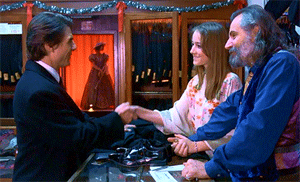 Standing behind his business counter, the shop owner sells his underage daughter as if she was another product. After enjoying masked slaves in lavish rituals, Bill sees the other side of the “trade”: Young girls being sold by exploitative people to a system feeding on minors, turning them into MK slaves. Is that why this store was called “Rainbow”?
Standing behind his business counter, the shop owner sells his underage daughter as if she was another product. After enjoying masked slaves in lavish rituals, Bill sees the other side of the “trade”: Young girls being sold by exploitative people to a system feeding on minors, turning them into MK slaves. Is that why this store was called “Rainbow”?Bill’s journey is, therefore, one that continually alternates between the primal allure of lust and the destructive social constructs that are erected around it. There is nothing more basic and instinctual than carnal attraction, but our modern world has made these relations complex, bound by rules, and prone to exploitation.
While lust is nature’s way of pushing humans to procreate, social constructs have created all kinds of fetishes, distortions, games, and perversions around this primal urge … to the point that it has been denatured and debased into an unhealthy obsession.As Bill navigates between joy and pain, monogamous marriage and anonymous debauchery, we notice that there’s a common thread uniting his various encounters.
Red-Headed WomenThe most important women in the movie are Bill’s wife, his daughter Helena, Amanda (the Beta slave who was sacrificed at the ritual) and Domino (a prostitute he met on the street).
All three adult women are somewhat physically similar as they are tall, well-proportioned, and red-headed. They also appear to be connected on “another level”.
While Alice is a respectable, upper-class lady, she makes a living using her looks in a loveless relationship, a little like what a prostitute would do. On the other hand, the time spent between Bill and Domino is sweet and tender, a little with what happens in a loving relationship. Alice is therefore not very different from Domino, and vice-versa.
There are also links with Amanda.
While Alice was (probably) not at the occult ritual attended by Bill, when he comes back from it, she describes to him a dream that is similar to what he just witnessed and what Amanda just experienced.“He was kissing me. Then we were making love. Then there were all these other people around us, hundreds of them, everywhere. Everyone was f-cking. And then I …I was f-cking other men. So many. I don’t know how many I was with. And I knew you could see me in the arms of all these men … just f-cking all these men.”
Alice’s dream “connects” her with Amanda who was at the ritual and who actually lived Alice’s dream.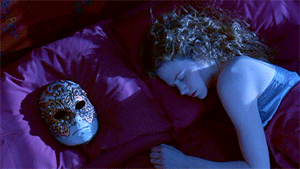 The day after the ritual, Bill finds his mask creepily “sleeping” next to his wife. Is this Alice’s way of saying that she’s aware of what’s going on? Maybe that she’s participating in this? Is it a warning from the secret society? Alice never acknowledges the mask, so I guess we’ll never know.Was Domino in the ritual? It is also interesting to point out that “Domino” is a type of mask used in these types of gatherings.
The day after the ritual, Bill finds his mask creepily “sleeping” next to his wife. Is this Alice’s way of saying that she’s aware of what’s going on? Maybe that she’s participating in this? Is it a warning from the secret society? Alice never acknowledges the mask, so I guess we’ll never know.Was Domino in the ritual? It is also interesting to point out that “Domino” is a type of mask used in these types of gatherings.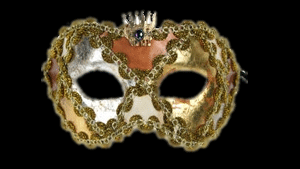 A Domino mask
A Domino maskLooking closer at the “magic circle” formed by the women of the ritual, we can identify a few women who could be Domino. The day after the ritual, Bill shows up at Domino’s house with a gift, but her roommate informs him that she is HIV-positive … and that she might never be back again. Is this true or was Domino yet another “casualty” in Bill’s journey?
Like Amanda and Nightingale, Domino mysteriously disappears after the ritual.
The fact that these women are all connected reveals one fundamental fact: Bill’s journey is not about a specific woman, it is about the feminine principle as a whole. It is an esoteric quest to understand and “be one with” the feminine principle that is opposite to his.Helena Down the Same Path?Throughout the movie, Helena (Bill’s daughter) is shown to be groomed to be another Alice.
There are also some cues linking Helena to Domino. For instance, there’s a stroller in front of Domino’s apartment and, at the end in the movie, in the toy store, Helena is very interested in a stroller and shows it to her mother. Domino on her bed with a stuffed feline, a symbol of Beta Kitten programming.
Domino on her bed with a stuffed feline, a symbol of Beta Kitten programming. An entire row of this exact same toy is at the store where Helena shops in the final scene of the movie.There is also something strange about the scene above: The two men behind Helena happened to be at Ziegler’s party at the very beginning of the movie.
An entire row of this exact same toy is at the store where Helena shops in the final scene of the movie.There is also something strange about the scene above: The two men behind Helena happened to be at Ziegler’s party at the very beginning of the movie.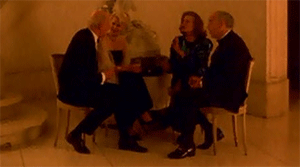 The two same men at Ziegler’s party: same hair, same physical stature and the guy on the right wears similar glasses.
The two same men at Ziegler’s party: same hair, same physical stature and the guy on the right wears similar glasses.Why are these two men in the store, looking at toys? Is New York City such a small town? Was Kubrick lacking extras to appear in that scene? Unlikely.
Could it be that they’re part of the secret society that’s been following Bill and his family? Strange fact: When the men walk away and disappear from the shot, Helena appears to follow them … and we don’t see her for the rest of the movie. The camera indeed zooms onto Alice and Bill, who are completely absorbed with themselves. Is this a VERY subtle way of saying that their daughter will be sucked in by the Beta slave system of the secret society? Another enigma.In ConclusionStanley Kubrick’s works are never strictly about love or relationships. The meticulous symbolism and the imagery of all of his works often communicate another dimension of meaning -- one that transcends the personal to become a commentary on our epoch and civilization. And, in this transitional period between the end of 20th century and the beginning of the 21st century,
Kubrick told the story of a confused man who wanders around, desperately looking for a way to satisfy his primal urges. Kubrick told the story of a society that is completely debased and corrupted by hidden forces, where humanity’s most primal urge -- procreation -- has been cheapened, fetishized, perverted and exploited to a point that it has lost all of its beauty. At the top of this world is a secret society that revels in this context, and thrives on it. Kubrick’s outlook on the issue was definitely not idealistic nor very optimistic.
His grim tale focuses on a single man, Bill, who is looking for an undefined something. Even if he appears to have everything, there is something missing in his life. Something visceral and fundamental that is never put into words, but that is quite palpable. Bill cannot be complete if he is not at peace with the opposite of him: the feminine principle. Bill’s quest, therefore, follows the esoteric principle of uniting two opposing forces into one. As suggested by the last lines of the movie, Bill will ultimately “be one” and get physical with his wife. After that, the alchemical process and the Tantric ritual would be complete. However, as Kubrick somehow communicates in the final scene, even if these two extremely self-absorbed, egotistical and superficial people believe they’ve reached some kind of epiphany, what does it really change? Our civilization as a whole still has its eyes wide shut … and those were Kubrick’s last cinematographic words.
